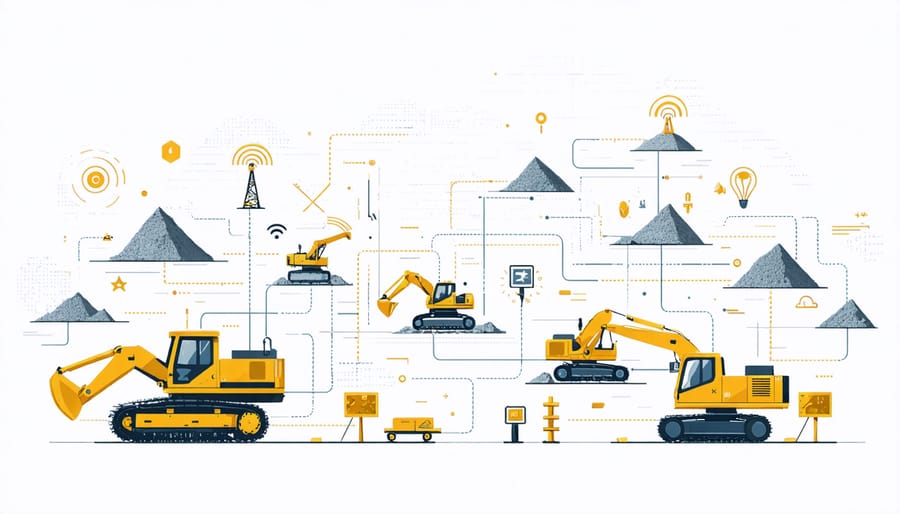The convergence of 5G technology and the Internet of Things (IoT) is revolutionizing how natural stone industry professionals monitor, manage, and optimize their operations. From smart quarries equipped with real-time sensors to automated stone processing facilities, this powerful combination delivers unprecedented connectivity, speed, and precision. With ultra-low latency and the ability to connect up to one million devices per square kilometer, 5G IoT networks are transforming traditional stone workflows into intelligent, data-driven systems that enhance efficiency, reduce waste, and improve quality control.
Industry leaders implementing 5G IoT solutions report up to 40% improvement in operational efficiency and a 30% reduction in maintenance costs. Remote monitoring capabilities now enable quarry operators to track equipment performance, predict maintenance needs, and optimize extraction patterns through advanced sensor networks. Meanwhile, fabricators leverage connected systems to maintain precise control over cutting operations, inventory management, and quality assurance processes.
This technological advancement isn’t just reshaping industrial operations – it’s also enabling innovative applications in finished stone installations. Smart sensors embedded in stone surfaces can now monitor structural integrity, temperature variations, and moisture levels, providing real-time data for proactive maintenance and enhanced durability.
How 5G Revolutionizes Natural Stone Operations
Speed and Connectivity Advantages
5G technology represents a quantum leap in wireless connectivity, delivering speeds up to 100 times faster than 4G networks. This breakthrough is revolutionizing natural stone production and monitoring systems through ultra-low latency and enhanced bandwidth capabilities. With download speeds reaching 20 gigabits per second, 5G enables real-time data transmission from thousands of connected sensors and devices simultaneously.
This superior connectivity allows for instant monitoring of stone cutting equipment, environmental conditions, and quality control parameters. Quarry operators can now receive immediate feedback on equipment performance, while fabricators can track multiple production lines with millisecond precision. The network’s ability to handle massive device density – up to one million connected devices per square kilometer – makes it ideal for large-scale stone processing facilities and smart construction sites.
The reduced latency of 5G, as low as one millisecond, ensures that critical control systems respond instantly to changing conditions, enhancing both safety and efficiency. This immediate response capability is particularly valuable in automated cutting operations and robotic stone placement systems, where precision and timing are crucial for success.
Enhanced Device Integration
The integration of 5G technology enables unprecedented connectivity for stone industry operations, supporting up to one million devices per square kilometer. This massive device density revolutionizes how quarries, fabrication facilities, and installation sites monitor and manage their operations. Smart sensors throughout the production chain can now communicate in real-time, tracking everything from block extraction to final installation.
In modern stone facilities, networks of IoT devices monitor equipment performance, material movement, and environmental conditions. Temperature sensors ensure optimal conditions for adhesive curing, while moisture meters track water content in processing areas. Motion sensors and RFID tags help trace stone slabs through the facility, reducing loss and optimizing inventory management.
The enhanced device integration also enables predictive maintenance systems that monitor cutting equipment, polishing machines, and transport vehicles. These systems can detect potential issues before they cause downtime, significantly improving operational efficiency. For installed stone features, embedded sensors can monitor structural integrity, temperature variations, and wear patterns, ensuring longevity and proper maintenance scheduling.
This comprehensive device network creates a more intelligent, responsive stone industry ecosystem, where data-driven decisions lead to better outcomes and reduced waste.

Smart Quarry Management with 5G IoT
Real-time Equipment Monitoring
5G IoT enables unprecedented real-time monitoring capabilities for equipment and machinery across the natural stone industry. Advanced sensor networks now track everything from quarry excavators to cutting machines, providing instant data on performance, maintenance needs, and operational efficiency.
These monitoring systems use a dense network of sensors that communicate through 5G’s ultra-reliable low-latency communication (URLLC) features. Equipment operators receive immediate alerts about machine status, temperature variations, vibration levels, and potential maintenance issues. This proactive approach helps prevent costly breakdowns and extends equipment lifespan.
In stone processing facilities, smart sensors monitor cutting tools’ wear patterns and automatically adjust cutting speeds for optimal performance. Environmental sensors track dust levels, humidity, and temperature, ensuring ideal working conditions for both equipment and personnel.
The high bandwidth of 5G allows for simultaneous monitoring of hundreds of devices without network congestion. Real-time video feeds from equipment-mounted cameras enable remote supervision and troubleshooting, while AI-powered analytics predict maintenance needs before issues arise.
For mobile equipment like forklifts and cranes, 5G-enabled GPS tracking provides precise location data and movement patterns, optimizing fleet management and workplace safety. The system can automatically generate maintenance schedules based on actual usage patterns rather than fixed time intervals, resulting in significant cost savings and improved operational efficiency.
Automated Quality Control
The integration of 5G IoT with AI-powered quality assessment systems has revolutionized quality control processes in the natural stone industry. These automated systems utilize high-resolution cameras and sensors connected through ultra-fast 5G networks to detect imperfections, variations in color, and structural integrity issues in real-time.
Smart sensors deployed throughout the manufacturing process continuously monitor stone slabs for defects, analyzing parameters such as surface texture, veining patterns, and dimensional accuracy. The low latency of 5G enables instant data transmission and processing, allowing for immediate adjustments to cutting and polishing operations when deviations are detected.
Machine learning algorithms learn from historical data to improve detection accuracy over time, reducing human error and ensuring consistent quality standards. The system can process thousands of stone surfaces per hour, identifying subtle variations that might be missed by traditional inspection methods.
Real-time monitoring extends beyond the factory floor to installation sites, where IoT devices track environmental conditions affecting stone performance. Moisture sensors, temperature monitors, and strain gauges provide continuous feedback about installation quality and potential issues, enabling proactive maintenance and preventing costly repairs.
This automated approach has significantly reduced waste, improved production efficiency, and elevated quality standards across the industry. Manufacturers can now provide detailed quality reports and authenticity certificates for each stone piece, enhancing transparency and customer confidence.

Smart Home Integration for Natural Stone Products
Connected Countertops and Surfaces
The integration of 5G technology with natural stone surfaces is revolutionizing how we interact with our countertops and other stone installations. Modern smart home stone integration enables features like embedded temperature sensors, touch-sensitive controls, and wireless charging capabilities directly within stone surfaces.
These connected countertops can monitor food safety by detecting harmful bacteria, alert homeowners to potential stains before they set, and even display cooking instructions or recipes through projection technology. Integrated weight sensors can track inventory and automatically generate shopping lists when supplies run low, while smart lighting systems embedded within translucent stone panels adjust ambiance based on time of day or user preferences.
Maintenance becomes proactive with sensors that monitor surface conditions, detecting microscopic cracks or potential damage before they become visible. The system can automatically schedule maintenance or alert homeowners to needed care, extending the life of stone installations.
For commercial applications, these smart surfaces can track usage patterns, maintain hygiene standards, and integrate with building management systems for enhanced efficiency and safety compliance.

Maintenance Automation
The integration of 5G IoT technology has revolutionized maintenance practices across industries, particularly in smart stone maintenance systems. Through a network of advanced sensors and real-time monitoring devices, maintenance teams can now detect potential issues before they become critical problems. These systems continuously track equipment performance, material conditions, and environmental factors, enabling predictive maintenance strategies that significantly reduce downtime and repair costs.
Automated maintenance solutions powered by 5G IoT can monitor everything from temperature fluctuations to vibration patterns in stone processing equipment. When unusual patterns are detected, the system automatically alerts maintenance personnel and can even initiate preventive measures. This proactive approach helps extend equipment lifespan and ensures optimal performance of stone processing operations.
The high-speed, low-latency capabilities of 5G enable real-time data analysis and instant response to maintenance needs. For example, automated maintenance systems can adjust equipment settings on the fly, schedule routine maintenance during off-peak hours, and coordinate with inventory systems to ensure replacement parts are always available when needed. This level of automation not only improves operational efficiency but also reduces human error and maintenance-related accidents.
Implementation Challenges and Solutions
Infrastructure Requirements
The implementation of 5G IoT requires substantial infrastructure development and strategic investment. Key components include the deployment of small cell networks, which consist of compact base stations installed throughout urban areas to ensure comprehensive coverage. These cells must be positioned approximately every 250-500 meters due to 5G’s shorter wavelengths.
Fiber optic backhaul networks are essential to connect these small cells and handle the massive data throughput. Network operators need to install or upgrade existing fiber infrastructure to support the increased bandwidth demands of 5G IoT applications.
Edge computing facilities must be established closer to end-users to reduce latency and process data more efficiently. This includes micro data centers distributed throughout service areas, rather than relying solely on centralized facilities.
Hardware upgrades are necessary at both network and device levels. This encompasses new antenna systems, updated routing equipment, and IoT-enabled devices with 5G capabilities. The investment extends to power infrastructure, as 5G networks require more energy-dense power solutions to maintain reliable operations.
Urban planning and regulatory compliance also play crucial roles, as cities must accommodate new infrastructure while adhering to local guidelines and aesthetic requirements.
Security Considerations
As 5G IoT devices become more prevalent in the natural stone industry, security considerations must be paramount. Data encryption and authentication protocols are essential to protect sensitive information transmitted between connected devices, from quarry sensors to smart fabrication equipment. Regular security audits and updates help maintain system integrity and prevent unauthorized access.
Privacy measures should include strict access controls, data anonymization, and compliance with regional data protection regulations. Companies must implement robust cybersecurity frameworks to safeguard proprietary information about stone processing techniques and customer data. Multi-factor authentication and secure network segmentation help prevent potential breaches.
Industry professionals should also consider physical security measures for IoT devices installed in quarries and fabrication facilities. Regular staff training on security best practices and incident response procedures is crucial. Additionally, working with reputable IoT service providers who maintain high security standards and offer regular firmware updates helps ensure long-term system protection.
By prioritizing security in 5G IoT implementations, stone industry stakeholders can confidently embrace these technological advances while protecting their assets and customer information.
Future Outlook
The convergence of 5G and IoT technologies promises transformative developments in the coming years. Industry experts predict that by 2025, there will be over 75 billion connected IoT devices globally, with 5G serving as the backbone for this massive network expansion. This growth will enable unprecedented applications in smart cities, industrial automation, and consumer technologies.
In the natural stone industry, 5G IoT integration will revolutionize quarry operations through autonomous machinery and real-time monitoring systems. Smart sensors embedded in stone installations will provide detailed data about material performance, maintenance needs, and environmental conditions, enabling predictive maintenance and enhanced longevity of stone applications.
Emerging trends point toward the development of self-maintaining stone surfaces, where IoT sensors coupled with 5G connectivity can automatically detect and respond to environmental stressors. This technology will be particularly valuable in heritage preservation and high-value architectural installations.
The miniaturization of IoT sensors and advancement in battery technology will make it possible to integrate smart capabilities into even the most delicate stone applications without compromising aesthetic appeal. Future developments in edge computing, combined with 5G’s low latency, will enable real-time decision-making for smart stone installations.
However, challenges remain in standardizing IoT protocols and ensuring cybersecurity across interconnected systems. Industry stakeholders are actively working on developing robust security frameworks and interoperability standards to address these concerns.
As 5G networks continue to expand globally, we can expect to see innovative applications that blend traditional stone craftsmanship with cutting-edge technology, creating smarter, more sustainable, and more responsive built environments.
The convergence of 5G technology and IoT represents a transformative leap forward in how we connect, monitor, and optimize our world. Through dramatically increased speeds, near-zero latency, and the ability to connect massive numbers of devices simultaneously, 5G IoT is revolutionizing industries from manufacturing to healthcare, smart cities to agriculture.
The benefits are clear and compelling: enhanced operational efficiency, real-time data analytics, improved safety and security, reduced energy consumption, and unprecedented automation capabilities. Organizations implementing 5G IoT solutions are seeing tangible results in cost savings, productivity gains, and innovative service delivery.
As we look to the future, the potential for 5G IoT continues to expand. From enabling autonomous vehicles to powering smart infrastructure, this technology will play an increasingly vital role in shaping our connected world. The ecosystem of compatible devices and applications grows daily, making adoption more accessible and valuable for businesses and consumers alike.
For those considering implementation, the time to act is now. While challenges exist in areas such as infrastructure development and security protocols, the competitive advantages and operational benefits far outweigh these temporary hurdles. By embracing 5G IoT technology today, organizations position themselves at the forefront of digital transformation, ready to capitalize on the next wave of innovation in our increasingly connected world.










